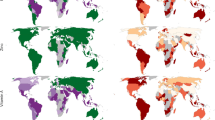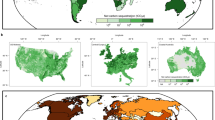Abstract
Twenty-first-century challenges for food and nutrition security include the spread of obesity worldwide and persistent undernutrition in vulnerable populations, along with continued micronutrient deficiencies. Climate change, increasing incomes and evolving diets complicate the search for sustainable solutions. Projecting to the year 2050, we explore future macronutrient and micronutrient adequacy with combined biophysical and socioeconomic scenarios that are country-specific. In all scenarios for 2050, the average benefits of widely shared economic growth, if achieved, are much greater than the modelled negative effects of climate change. Average macronutrient availability in 2050 at the country level appears adequate in all but the poorest countries. Many regions, however, will continue to have critical micronutrient inadequacies. Climate change alters micronutrient availability in some regions more than others. These findings indicate that the greatest food security challenge in 2050 will be providing nutritious diets rather than adequate calories. Research priorities and policies should emphasize nutritional quality by increasing availability and affordability of nutrient-dense foods and improving dietary diversity.
This is a preview of subscription content, access via your institution
Access options
Access Nature and 54 other Nature Portfolio journals
Get Nature+, our best-value online-access subscription
$29.99 / 30 days
cancel any time
Subscribe to this journal
Receive 12 digital issues and online access to articles
$119.00 per year
only $9.92 per issue
Buy this article
- Purchase on Springer Link
- Instant access to full article PDF
Prices may be subject to local taxes which are calculated during checkout





Similar content being viewed by others

Data availability
The data and code used for this analysis are available for download at https://github.com/GeraldCNelson/nutrientModeling. The software code is open source under the GNU General Public License, version 3 or higher. Country-specific modelling results and more detailed information on modelling are available for download at http://impactnutrients.ifpri.org/nutrientModeling/. The corresponding author is prepared to respond to reasonable requests for code, data and results queries.
References
Nelson, G. C. et al. Climate change effects on agriculture: economic responses to biophysical shocks. Proc. Natl Acad. Sci. USA 111, 3274–3279 (2014).
Wiebe, K. et al. Climate change impacts on agriculture in 2050 under a range of plausible socioeconomic and emissions scenarios. Environ. Res. Lett. 10, 085010 (2015).
Tilman, D. & Clark, M. Global diets link environmental sustainability and human health. Nature 515, 518–522 (2014).
Springmann, M. et al. Global and regional health effects of future food production under climate change: a modelling study. Lancet 387, 1937–1946 (2016).
Hertel, T. W. Food security under climate change. Nat. Clim. Change 6, 10–13 (2015).
Medek, D. E., Schwartz, J. & Myers, S. S. Estimated effects of future atmospheric CO2 concentrations on protein intake and the risk of protein deficiency by country and region. Environ. Health Perspect. https://doi.org/10.1289/EHP41 (2017).
Myers, S. S. et al. Increasing CO2 threatens human nutrition. Nature 510, 139–142 (2014).
Myers, S. S., Wessells, K. R., Kloog, I., Zanobetti, A. & Schwartz, J. Effect of increased concentrations of atmospheric carbon dioxide on the global threat of zinc deficiency: a modelling study. Lancet Glob. Health 3, e639–e645 (2015).
Smith, M. R., Golden, C. D. & Myers, S. S. Potential rise in iron deficiency due to future anthropogenic carbon dioxide emissions. GeoHealth 1, 248–257 (2017).
Smith, M. R. & Myers, S. S. Impact of anthropogenic CO2 emissions on global human nutrition. Nat. Clim. Change 8, 834–839 (2018).
Moss, R. H. et al. The next generation of scenarios for climate change research and assessment. Nature 463, 747–756 (2010).
Jones, C. D. et al. The HadGEM2-ES implementation of CMIP5 centennial simulations. Geosci. Model Dev. 4, 543–570 (2011).
Bennett, M. K. Wheat in national diets. Wheat Stud. 18, 37–76 (1941).
Palacios, C. & Gonzalez, L. Is vitamin D deficiency a major global public health problem?. J. Steroid Biochem. Mol. Biol. 144, 138–145 (2014).
Fern, E. B., Watzke, H., Barclay, D. V., Roulin, A. & Drewnowski, A. The Nutrient Balance Concept: a new quality metric for composite meals and eiets. PLoS ONE 10, e0130491 (2015).
Popkin, B. M. & Gordon-Larsen, P. The nutrition transition: worldwide obesity dynamics and their determinants. Int. J. Obes. 28, S2–S9 (2004).
Nelson, G. C. et al. Food Security and Climate Change: Challenges to 2050 and Beyond (IFPRI, 2010).
Deutsch, C. A. et al. Increase in crop losses to insect pests in a warming climate. Science 361, 916–919 (2018).
Kimball, B. A. et al. Elevated CO2, drought and soil nitrogen effects on wheat grain quality. New Phytol. 150, 295–303 (2001).
Loladze, I. Hidden shift of the ionome of plants exposed to elevated CO2 depletes minerals at the base of human nutrition. eLife https://doi.org/10.7554/eLife.02245 (2014).
Kjellstrom, T. et al. Heat, human performance, and occupational health: a key issue for the assessment of global climate change impacts. Annu. Rev. Public Health 37, 97–112 (2016).
Herrero, M. & Thornton, P. K. Livestock and global change: emerging issues for sustainable food systems. Proc. Natl Acad. Sci. USA 110, 20878–20881 (2013).
Robinson, S. et al. The International Model for Policy Analysis of Agricultural Commodities and Trade (IMPACT): Model Description for Version 3 (IFPRI, 2015).
Andersen, L. E. et al. Climate Change Impacts: Prospects for 2050 in Brazil, Mexico, and Peru https://doi.org/10.2499/9780896295810 (2016).
Rao, N. D., van Ruijven, B. J., Riahi, K. & Bosetti, V. Improving poverty and inequality modelling in climate research. Nat. Clim. Change 7, 857–862 (2017).
van Ruijven, B. J., O’Neill, B. C. & Chateau, J. Methods for including income distribution in global CGE models for long-term climate change research. Energy Econ. 51, 530–543 (2015).
Colombo, G. Linking CGE and microsimulation models: a comparison of different approaches. Int. J. Microsimulation 3, 72–91 (2010).
Willenbockel, D. et al. Dynamic Computable General Equilibrium Simulations in Support of Quantitative Foresight Modeling to Inform the CGIAR Research Portfolio: Linking the IMPACT and GLOBE Models (IFPRI, 2018).
Decision Support System for Agrotechnology Transfer (DSSAT) Version 4.6 (DSSAT, 2015).
Long, S. P., Ainsworth, E. A., Leakey, A. D. B., Nosberger, J. & Ort, D. R. Food for thought: lower-than-expected crop yield stimulation with rising CO2 concentrations. Science 312, 1918–1921 (2006).
Zavala, J. A., Casteel, C. L., DeLucia, E. H. & Berenbaum, M. R. Anthropogenic increase in carbon dioxide compromises plant defense against invasive insects. Proc. Natl Acad. Sci. USA 105, 5129–5133 (2008).
Bloom, A. J., Burger, M., Kimball, B. A. & Pinter, P. J. Jr. Nitrate assimilation is inhibited by elevated CO2 in field-grown wheat. Nat. Clim. Change 4, 477–480 (2014).
Jones, A. G., Scullion, J., Ostle, N., Levy, P. E. & Gwynn-Jones, D. Completing the FACE of elevated CO2 research. Environ. Int. 73, 252–258 (2014).
USDA Table of Nutrient Retention Factors, Release 6 (USDA, 2007).
Composition of Foods Raw, Processed, Prepared: USDA National Nutrient Database for Standard Reference, Release 28 (USDA, 2015).
Dufresne, J.-L. et al. Climate change projections using the IPSL-CM5 Earth System Model: from CMIP3 to CMIP5. Clim. Dyn. 40, 2123–2165 (2013).
Dunne, J. P. et al. GFDL’s ESM2 global coupled climate–carbon Earth System Models. Part I: Physical formulation and baseline simulation characteristics. J. Clim. 25, 6646–6665 (2012).
Wiebe, K. et al. Climate change impacts on agriculture in 2050 under a range of plausible socioeconomic and emissions scenarios. Environ. Res. Lett. 10, 85010 (2015).
Von Lampe, M. et al. Why do global long-term scenarios for agriculture differ? An overview of the AgMIP Global Economic Model Intercomparison. Agric. Econ. 45, 3–20 (2014).
Forster, P. M. et al. Evaluating adjusted forcing and model spread for historical and future scenarios in the CMIP5 generation of climate models. J. Geophys. Res. Atmos. 118, 1139–1150 (2013).
Acknowledgements
The authors thank their respective institutions for support. CSIRO authors acknowledge funding from the CSIRO Science Leaders Programme, the CGIAR Research Programme on Climate Change Agriculture and Food Security (grant no. 20140604, CCAFS CSIRO Sustainable diets) and the Bill and Melinda Gates Foundation (grant no. OPP1134229). IFPRI authors acknowledge the financial support of the CGIAR Research Program on Policies, Institutions and Markets (PIM), Agriculture for Nutrition and Health (A4NH) and CCAFS. K.L. acknowledges financial support from HarvestPlus. J.A. acknowledges the World Food Center at UC Davis for providing initial support for her involvement in this effort. D.G. acknowledges the financial contributions provided by the ILSI Research Foundation and related partners for its initial support of his participation. The authors also thank J. W. Jones for suggesting the methodological approach used here, E. Fern for guidance in the use of the nutrient balance score, S. Wood for insights into choice of diversity metrics, Z. Li for R code for Rao’s quadratic entropy measure and A. Bunning and L. Unnevehr for helpful comments on earlier drafts. Any errors are the responsibility of the authors.
Author information
Authors and Affiliations
Contributions
G.N. is corresponding author. G.N., M.H., D.G. and K.W. conceived and planned the paper. G.N., J.B., and K.L. wrote the paper with edits from all authors. J.B., K.L., J.A., M.R. and K.C. were responsible for data selection and manipulation for the nutrient content and interpretation of nutrient results. T.S., D.M., K.W. and M.R. were responsible for development and implementation of the socioeconomic modelling, including links to climate model outputs. D.G., K.C. and R.R. were responsible for metric choice and details of implementation. G.N. and B.P. developed the R code used to produce the results. All authors provided ongoing comments and edits from initial inception to delivery of final version.
Corresponding author
Ethics declarations
Competing interests
The authors declare that they have no competing financial or nonfinancial interests.
Additional information
Publisher’s note: Springer Nature remains neutral with regard to jurisdictional claims in published maps and institutional affiliations.
Supplementary information
Supplementary Information
Supplementary Figs. 1–17, Supplementary Tables 1–7, Supplementary references 1–60.
Rights and permissions
About this article
Cite this article
Nelson, G., Bogard, J., Lividini, K. et al. Income growth and climate change effects on global nutrition security to mid-century. Nat Sustain 1, 773–781 (2018). https://doi.org/10.1038/s41893-018-0192-z
Received:
Accepted:
Published:
Issue Date:
DOI: https://doi.org/10.1038/s41893-018-0192-z
This article is cited by
-
Climatic risks to adaptive capacity
Mitigation and Adaptation Strategies for Global Change (2024)
-
Stakeholder-driven transformative adaptation is needed for climate-smart nutrition security in sub-Saharan Africa
Nature Food (2024)
-
Global food nutrients analysis reveals alarming gaps and daunting challenges
Nature Food (2023)
-
Livestock exposure to future cumulated climate-related stressors in West Africa
Scientific Reports (2023)
-
Low-carbon diets can reduce global ecological and health costs
Nature Food (2023)


